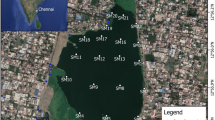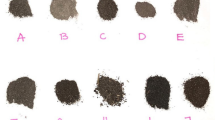Abstract
The objective of this study is to evaluate the level and characteristics of metal contamination for the samples from the artificial lake in the urban area. The results show that sediment concentrations of typical anthropogenic contaminants, Zn, Cu, and Ni, are overall high above the sediment quality guideline. The sequential extraction results for the sediment indicate that Pb as well as Zn and Cu show the high potential for the bioavailability to the aquatic organisms in the lake. The concentrations of Pb, Zn, Cr, are high for the runoff water, which is the major pollution source to the lake, but the lake water concentration is below regulatory level. Given high metal concentrations from soils near the polluted runoff path to the lake are higher than those from soils from other sides of the lake, this relatively low contamination of the lake water is likely due to the role of the surrounding soil as a buffer. Thus, when the artificial lake is designed in the urban area, application of soil buffer such as the grassplot or the plant strip along the vicinity of the lake is recommended.
Similar content being viewed by others
References
Adriano, D. C. (2001). Trace elements in the terrestrial environment, Springer-Verlag, New York, USA.
Baek, Y.-W. and An, Y.-J. (2010). “Assessment of toxic heavy metals in urban lake sediments as related to urban stressor and bioavailability.” Environmental Monitoring and Assessment, Vol. 171, Nos. 1–4, pp. 529–537, DOI: 10.1007/s10661-009-1297-7.
Birch, S. and McCaskie, J. (1999). “Shallow urban lakes: A challenge for lake management.” Hydrobiologia, Vol. 395–396, pp. 365–378, DOI: 10.1023/A:1017099030774.
Carlisle, T. J. and Mulamoottil, G. (1991). “Artificial wetlands for the treatment of stormwater.” Canadian Water Resources Journal, Vol. 16, No. 4, pp. 331–343, DOI: 10.4296/cwrj1604331.
Cheremisinoff, P. N. (1993). Water management and supply, PTR Prentice Hall, Englewood Cliffs, USA.
Cooke, G. D., Welch, E. B., Peterson, S. A., and Nichols, S. A. (2005). Restoration and management of lakes and reservoir, CRC Press, Boca Raton, USA.
Davis, D. L., Bell, M. L., and Fletcher, T. (2002). “A look back at the London smog of 1952 and the half century since.” Environmental Health Perspectives, Vol. 110, No. 12, pp. A734–735.
Gibson, M. J. and Farmer, J. G. (1986). “Multi-step sequential chemical extraction of heavy metals from urban soils.” Environmental Pollution Series B, Chemical and Physical, Vol. 11, No. 2, pp. 117–135, DOI: 10.1016/0143-148X(86)90039-X.
Halliday, S. (1999). The Great Stink of London: Sir Joseph Bazalgette and the Cleansing of the Victorian Capital, Sutton, UK.
Harrison, R. M., Laxen, D. P. H., and Wilson, S. J. (1981). “Chemical associations of lead, cadmium, copper, and zinc in street dusts and roadside soils.” Environmental Science and Technology, Vol. 15, No. 11, pp. 1378–1383, DOI: 10.1021/es00093a013.
Hart, B. (1982). “Uptake of trace metals by sediments and suspended particulates: a review.” Hydrobiologia, Vol. 91–92, No. 1, pp. 299–313, doi:10.1007/BF02391947.
Jung, G. B., Lee, J. S., Kim, W. I., Kim, J. H., and Yun, S. G. (2007). “Wet deposition of heavy metals in Suwon area.” Korean Journal of Environmental Agriculture, Vol. 26, No. 2, pp. 116–123.
KICT (Korea Institute of Construction Technology) (1997). Research on optimum water quality management of Ilsan lake, Goyang, Korea
KMOE (2005). Development of integrated methodology for evaluation of water environment (II), Gwacheon, Korea
KMOE (2013a). Soil environment conservation act, Gwacheon, Korea
KMOE (2013b). Water quality and ecosystem conservation act, Gwacheon, Korea.
KMOE (2014). Framework act on environmental policy, Sejong, Korea.
KMOE (Korean Ministry of the Environment) (2004). Development of integrated methodology for evaluation of water environment (I), Gwacheon, Korea.
Lee, P. K., Yu, Y. H., Yun S. T., and Shin S. C. (2003). “Spatial variability of heavy metal contamination of urban roadside sediments collected from gully pots in Seoul City.” Journal of Soil and Groundwater Environment, Vol. 8, No. 2, pp. 19–35.
Lindström, M. (2001). “Urban land use in influences of heavy metal fluxes and surface sediment concentrations of small lakes.” Water, Air, and Soil Pollution, Vol. 126, Nos. 3–4, pp. 363–383.
Molden, D. and Sakthivadivel, R. (1999). “Water accounting to assess use and productivity of water.” International Journal of Water Resources Development, Vol. 15, Nos. 1–2, pp. 55–71, DOI: 10.1080/07900629948934.
NOAA (National Oceanic and Atmospheric Administration) (1999). Sediment quality guidelines developed for the national status and trend programs, available at http://archive.orr.noaa.gov/book_shelf/121_sedi_qual_guide.pdf.
Ogawa, H. and Male, J. W. (1990). “Evaluation framework for wetland regulation.” Journal of Environmental Management, Vol. 30, No. 2, pp. 95–109, DOI: 10.1016/0301-4797(90)90008-K.
Onwumere G. C. (2000) An evaluation of highway stormwater runoff quality in the G.V.R.D., PhD Thesis, University of British Columbia, Dept. of Civil Engineering.
Pacifico, R., Adamo, P., Cremisini, C., Spaziani, F., and Ferrara, L. (2007). “A geochemical analytical approach for the evaluation of heavy metal distribution in lagoon sediments.” Journal of Soils and Sediments, Vol. 7, No. 5, pp. 313–325, DOI: 10.1065/jss2007.06.231.
Salomons, W. and Förstner, U. (1980). “Trace metal analysis on polluted sediments.” Environmental Technology Letters, Vol. 1, No. 11, pp. 506–517, DOI: 10.1080/09593338009384007.
Sezgin, N., Ozcan, H. K., Demir, G., Nemlioglu, S., and Bayat, C. (2004). “Determination of heavy metal concentrations in street dusts in Istanbul E-5 highway.” Environment International, Vol. 29, No. 7, pp. 979–985, DOI: 10.1016/S0160-4120(03)00075-8.
Sharma, A. K., Gray, S., Diaper, C., Liston, P., and Howe, C. (2008). “Assessing integrated water management options for urban developments — Canberra case study.” Urban Water Journal, Vol. 5, No. 2, pp. 147–159, DOI: 10.1080/15730620701736829.
Smith, B. H. (1993). “The effect of ocean and lake coast amenities on cities.” Journal of Urban Economics, Vol. 33, No. 1, pp. 115–123, DOI: 10.1006/juec.1993.1008.
Smith, L. G., Carlisle, T. J., and Meek, S. N. (1993). “Implementing sustainability: the use of natural channel design and artificial wetlands for stormwater management.” Journal of Environmental Management, Vol. 37, No. 4, pp. 241–257, DOI: 10.1006/jema.1993.1020.
Tessier, A., Campbell, P. G. C., and Bisson, M. (1979). “Sequential extraction procedure for the speciation of particulate trace metals.” Analytical Chemistry, Vol. 51, No. 7, pp. 844–851, DOI: 10.1021/ac50043a017.
Todd, D., Bedient, P., Haasbeek, J., and Noell, J. (1989). “Impact of land use and NPS loads on lake quality.” Journal of Environmental Engineering, Vol. 115, No. 3, pp. 633–649, DOI: 10.1061/(ASCE)0733-9372(1989)115:3(633).
USEPA (U.S. Environmental Protection Agency) (1994) Determination of Metals and Trace Elements in Water and Wastes by Inductively Coupled Plasma-atomic Emission Spectrometry, Method 200.7, Cincinnati, OH, USA.
Vicente-Martorell, J. J., Galindo-Riaño, M. D., García-Vargas, M., and Granado-Castro, M. D. (2009). “Bioavailability of heavy metals monitoring water, sediments and fish species from a polluted estuary.” Journal of Hazardous Materials, Vol. 162, Nos. 2–3, pp. 823–836, DOI: 10.1016/j.jhazmat.2008.05.106.
Walsh, C. (2000). “Urban impacts on the ecology of receiving waters: A framework for assessment, conservation and restoration.” Hydrobiologia, Vol. 431, Nos. 2–3, pp. 107–114, DOI: 10.1023/A:1004029715627.
Waltham, N. J., Teasdale, P. R., and Connolly, R. M. (2011). “Contaminants in water, sediment and fish biomonitor species from natural and artificial estuarine habitats along the urbanized Gold Coast, Queensland.” Journal of Environmental Monitoring, Vol. 13, No. 12, pp. 3409–3419, DOI: 10.1039/C1EM10664C.
Zafra, C. A., Temprano, J., and Tejero, I. (2011). “Distribution of the concentration of heavy metals associated with the sediment particles accumulated on road surfaces.” Environmental Technology, Vol. 32, No. 9, pp. 997–1008, DOI: 10.1080/09593330.2010.523436.
Author information
Authors and Affiliations
Corresponding author
Rights and permissions
About this article
Cite this article
Yang, K., Nam, T., Nam, K. et al. Characteristics of heavy metal contamination by anthropogenic sources in artificial lakes of urban environment. KSCE J Civ Eng 20, 121–128 (2016). https://doi.org/10.1007/s12205-015-0534-6
Received:
Revised:
Accepted:
Published:
Issue Date:
DOI: https://doi.org/10.1007/s12205-015-0534-6




